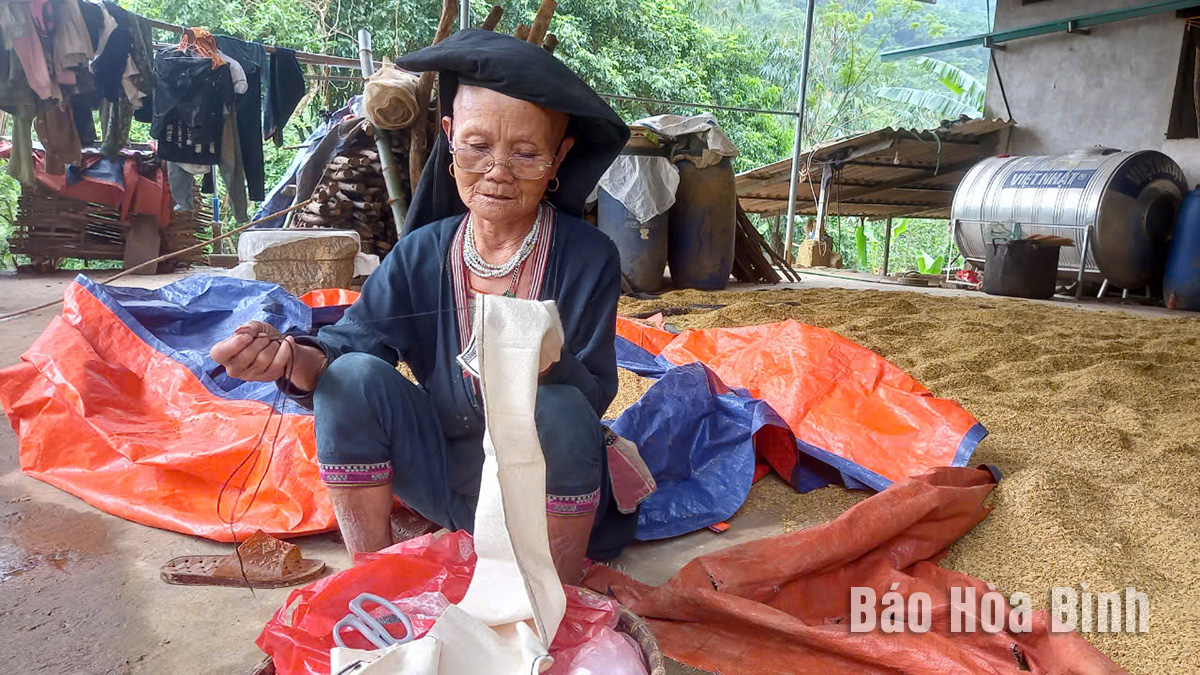
Suoi Ben is a remote village located about 40km away from Luong Son town, bordering Kim Boi district, with the majority of its households being Dao.
Phung Thi Thanh, who resides in Suoi Ben village, Lien Son commune, Luong Son district still preserves the traditional embroidery of Dao ethnic people.
A new cultural house was built in Suoi Ben village last year with funding from the National Target Programme for Socio-Economic Development in Ethnic Minority and Mountainous Areas. Covering an area of 180 sq.m, the project had a total investment of 1.3 billion VND (about 52,900 USD). Of which, 1.1 billion VND came from the State budget and the rest was raised among the community through labour contribution.
Duong Tai Phu, secretary of the village’s party cell said the village is home to 70 households with a population of 300. The main source of income for local residents comes from forest and agricultural production. Previously, its cultural house was too small, so village meetings or community activities had to be held at the village chief’s house or those with larger houses. This inconvenience made it difficult to carry out many tasks, especially the dissemination of the policies and guidelines of the Party and the State, which require gathering people in one place.
Dinh Manh Dong, an official of the Ethnic Affairs Division of Luong Son district, said as a district that has been recognised as meeting new-style rural standards, Luong Son prioritises investment in the most disadvantaged villages. Suoi Ben villagers contributed workday to build a new cultural house, along with support from the State budget, he said, elaborated that it was put into use in November last year, creating favourable conditions for community activities.
Duong Tai Chinh, a local resident, said that since the cultural house was put into use, it has hosted numerous cultural and sports events, along with meetings and dissemination campaigns to raise legal awareness among ethnic minority people, thus contributing to strengthening community bond. It also serves as a playground for children in the village to organise recreation activities, he added.
The secretary of the village’s party cell said that thanks to the new cultural house, organisation of community activities has become more convenient, therefore fostering connection among residents and encouraging them to actively pursue socio-economic development and sustainable poverty reduction.
Hoa Binh province has carried out multiple programmes and initiatives to revive its cultural heritage which has gradually fallen into oblivion through the ebbs and flows of history.
The most prominent and defining feature in the prehistoric era of Hoa Binh is the Hoa Binh Culture. The Culture was first discovered in Hoa Binh. The significant prehistoric culture represents not only Vietnam but also Southeast Asia and southern China. Through excavations of cave sites in the limestone regions of Hoa Binh, French archaeologist M. Colani introduced the world to a "Stone Age in Hoa Binh province – Northern Vietnam" in 1927. On January 30, 1932, the First Congress of Far Eastern Prehistorians, held in Hanoi, officially recognised the Hoa Binh Culture.
Known as the "Land of Epic History”, Hoa Binh province, the gateway to Vietnam’s northwest, boasts a strategic location and a unique cultural tapestry woven by its ethnic minority communities.
The People's Committee of Luong Son District recently held a ceremony to receive the certificate recognizing Sau Communal House in Thanh Cao Commune as a provincial-level historical and cultural site.
Recognising the importance of cultural heritage preservation in protecting and promoting the value system of Vietnamese culture, and serving socio-economic development in the new period, Party committees and local administrations in Hoa Binh province have identified it as a key task in the cultural development strategy. The province has been making efforts in mobilising resources, creating consensus among people and engaging ethnic communities in preserving and promoting cultural identity.
Hoa Binh province has captured growing attention both domestically and internationally for its distinctive cultural heritage and rich history. Most notably, it has been renowned for its famous Hoa Binh culture, considered the cradle of ancient Vietnamese civilisation. Looking ahead to significant milestones in 2025 and the 140th anniversary of province establishment in 2026, Hoa Binh Newspaper presents a comprehensive overview of the province's development across economic, social, cultural, tourism, and security domains.



